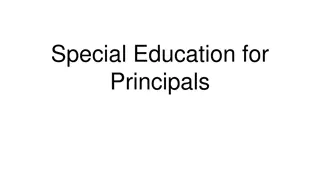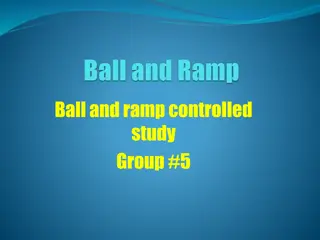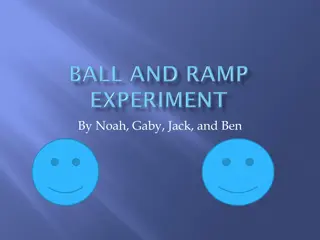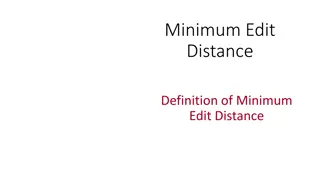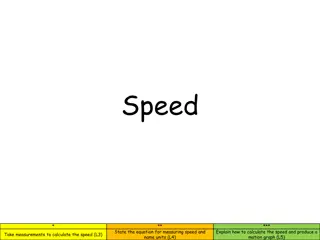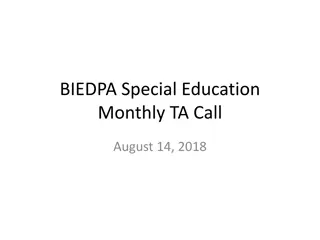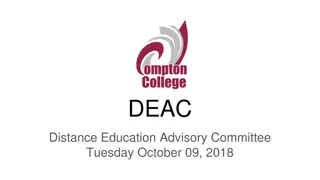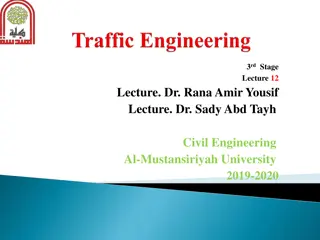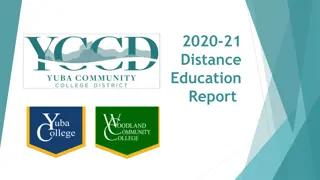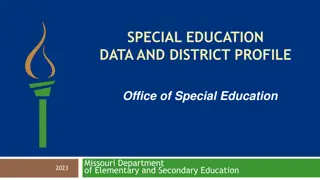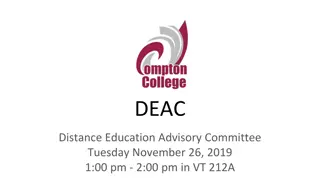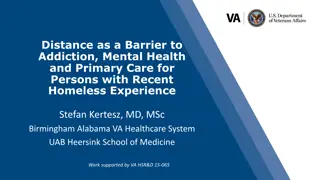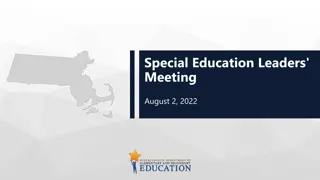Distance Learning for Special Education: Updates and Guidance
A webinar for special education directors focusing on adjusting specially designed instruction, unpacking the Specially Designed Instruction (SDI) Toolkit, and guidelines for distance learning related to social, emotional, and mental health, partnering with parents, families, and caregivers, instructional time, equity and access, and teaching and learning strategies.
Download Presentation

Please find below an Image/Link to download the presentation.
The content on the website is provided AS IS for your information and personal use only. It may not be sold, licensed, or shared on other websites without obtaining consent from the author. Download presentation by click this link. If you encounter any issues during the download, it is possible that the publisher has removed the file from their server.
E N D
Presentation Transcript
Distance Learning For All Updates Special Education Director s Webinar April 15, 2020 We will be starting soon. Please mute yourselves upon entering this meeting. Thank you!
Topics Covered Today Grounding in where we are Unpacking the Specially Designed Instruction Toolkit Section One: Guiding Principles Section Two: Planning for SDI Section Three: Amending IEPs Section Four: Sample Plans and Resources Open Sharing and Problem-Solving Questions on the Toolkit
Adjusting Specially Designed Instruction For my fellow rebel leaders those who have learned about equity, who are woke to how inequities are produced and perpetuated, who have built leadership skills to engage others in working toward equity, who have been trying to take action to change things we have been preparing for this moment of interruption, the moment when a great disturbance would bring the system to a halt. We are strong in what we know, strong in what we see, strong in what we want. We have to act courageously NOW so we can come back together differently. What if we Willing to be Disturbed
Unpacking the SDI Toolkit Section One Framing Values We acknowledge that our public education system creates a problematic paradox around who the system is designed to serve. It is true that students who experience disability have outcomes that are far from their potential due to factors of oppression ranging from ableism, racism, low expectations, and gross misunderstandings. Special education teachers and teams have worked for decades to erode these inequities and prove that students who experience disability can and should succeed in our schools.
Guidelines for Distance Learning Social, Emotional and Mental Health: Ensure safety, belonging and mental health as a foundation for learning. Prioritize care and connection. Apply a trauma-informed lens when providing services. Partnering with Parents, Families, and Caregivers: Center equity in all outreach and communication efforts with parents, families and caregivers. This includes honoring home language and culture and considering the strengths and needs of students. As educators, we have now become guests in the homes of the students and families we serve. Instructional Time: Establish routines, expectations and priorities to facilitate instruction. Consider the environments and ages of the learners when planning instructional time, activities and connections. Equity and Access: Ensure equity and access in all aspects of distance learning. Design instruction using the tenets of Universal Design for Learning (UDL) to create the greatest access for students. Differentiate and use a variety of modes, resources and strategies with consideration for how students and families may be disproportionately impacted. Teaching and Learning: Focus on essential learning, leveraging formative assessment and student assets to inform differentiation and extensions. Guarantee learning to support students on their path to college and career.
Guidelines for Distance Learning Operational and Administrative Logistics: Attendance: Every student is assigned to and regularly connects with a licensed or registered teacher. (Pending further guidance.) Report Progress: Provide and report on grades and/or progress marks. Provide Credit-Earning Options: Offer a variety of opportunities to earn high school credits. Time: Teacher-Led Learning will be bolstered by other learning opportunities throughout the day. Distance Learning: Sample Instructional Day (K-12), is designed to help teachers and parents build a daily learning schedule for students across K-12. This prioritizes Teacher-Led Learning and also expands learning to include activities and experiences that reinforce skills and extend knowledge. Special Education Teams should consider utilizing Teacher-Led time, Supplemental Activities, and Nutrition and Wellness times to include in the planning for specially designed instruction. Please also see the sample schedules available on the web page which include: time to complete assignments, enrichment time, academic time, free choice time, physical activity time, and other suggestions that will help fill out a complete day of learning for students.
Special Education Guidance Special Education teams should begin with a review of the Extended School Closure: Special Education Guidance document. The following steps are included as a starting place to review a student s Specially Designed Instruction. 1. Districts and schools must develop distance learning plans to provide educational services to all students under the Governor s Executive Order 20-08. Districts and schools should review student IEPs in context of the district s distance learning plan. To the maximum extent possible, the school team should implement the IEP as written, including Specially Designed Instruction, Related Services, and Supplementary Aids and Services. School Placement can be considered, but the general education move to Distance Plans does not require or constitute a change in placement for the student with an IEP. Review Table 1 for recommended next steps, if the school team is unable to provide FAPE while schools remain closed under the Executive Order. Districts should examine the effect of the closure on the student s progress toward their IEP goals and review the guidance for tracking goals during the closure 2. 3. 4. 5. 6.
Special Education Guidance Then the IEP Team must . If during the Extended School Closure and distance learning for all An IEP team determines the school/district cannot meet the requirements of the IEP as written Convene an IEP meeting, either virtually or on the phone, or Enter into a written agreement with the parent/guardian agreeing to amend the IEP Review the IEP goals, SDI, Related Services, and Supplementary Aids and Services Amend the IEP for the current setting and context, or Track and consider compensatory services once school resumes o o
Section Two: Review the IEPs Review the student s unique disability in relationship to the new learning context. For many of our students who experience disability, this closure represents the first time in their educational history that they will be included to the same extent as their peers without disabilities. This reality presents an opportunity to think creatively and boldly.
Review Specially Designed Instruction Service Type: In alignment with the student goals Minutes: Written based on the unique needs of the student and the goals Location: Will not need to be adjusted or amended due to the closure. All students' location of service will be in the home setting during the extended school closure regardless of the location expressed on the IEP. Provider: The provider will not need to be amended if LEA or ESD. If another provider is listed, the team must review to determine if a change is necessary and/or appropriate.
Review Specially Designed Instruction Key Questions to consider: What were you in the process of teaching before schools moved to extended closure? What activities did you have planned? What standards were you in the process of covering? Were there in-task schedules, task analysis, first then choices/boards that might be needed by learners and families to complete tasks and build learner independence? Can those be emailed, gathered from school, or printed and sent home? What goals are no longer relevant or need to be approached differently during Distance Learning for All (e.g., peer interaction goals)? "It is important to emphasize that federal disability law allows for flexibility in determining how to meet the individual needs of students with disabilities. USDOE Supple Fact Sheet 3.21.20
Evaluate the Minutes of SDI As teams consider how to provide SDI to students in a Distance Learning for All model, it is critical that they consider the full range of educational services provided through the districts Distance Learning for All plan. While it is true that ODE has recommended maximum daily guidelines for Teacher-Led Learning, that period of time should not comprise the entire Distance Learning for All experience. Teacher-Led Learning will be bolstered by other learning opportunities (i.e., Learning and Supplemental Activities, and Meeting Nutrition and Wellness Needs) throughout the day. This could mirror the school day, when students receive SDI during recess, peer interactions, lunch times, etc. SDI is not limited to 1:1 teacher instruction; therefore, SDI is not limited to Teacher-Led Learning times during the extended school closure.
Sample First Grade Student Teacher-Led Supplemental 225 minutes per week (45 minutes/day) 5-10 Hours per week (1-2 hours per day) Distance Learning activities offered by the general education teacher includes activities that target identifying letters, copying tasks, identifying numbers, counting activities (30 minutes of the 45 minutes per day) Reading Activities provided by the Teacher- 15 minutes/day The General Education Teacher collaborates with the Special Education Teacher on assigning courses. Book Read Alouds- 15 minutes per day parent or virtual SLP one time per week Sped teacher one time per week Speech- consults with parent one time per week to discuss activities and extension activities to do for the week (10 minutes) Special Education Teacher- collaborates with general education teacher on materials and accessibility/ phone calls with parents to discuss weekly lessons (15 minutes) Math Activities- 15 minutes per day Sensory and Developmental Play activities provided by the school- 15 minutes per day SDI- 165 minutes Speech- 10 minutes SDI- 75 minutes Reading Activities SDI- Read Aloud- 60 minutes Speech- Read Aloud- 15 minutes SDI- Math Activities 75 minutes SDI- Sensory and Play Activities 75 minutes SDI: 165 minutes per week* SPEECH: 10 minutes per week SDI: 285 MINUTES SPEECH: 15 MINUTES
Thinking about SDI Note that this represents a different take on how a district could choose to implement the IEP. As noted earlier, there is no one right way to provide support for students who experience disability through Distance Learning for All. We strongly encourage innovation and iteration in the process. First, focus on relationship and care for students and families Next, connect with them where they are Lastly in the toolkit, is compliance Each student will experience this school closure differently. Our job first is to provide care and connection and then focus on instruction.
Plan Instruction and Activities How do we develop transition/functional skills across home, work, community during school closure? Pair everyday skills together with academic skills (e.g., cooking projects, building projects, organizing projects). Include these skills in the daily schedule. Some work and community skills can be simulated online (e.g., grocery shopping, planning travel instructions, developing lists of community resources). It's a great time for research and gathering input on strengths and needs. Teams can have students and families track everyday skills that are challenging and those that students can perform independently during time at home. How do we help families and students maintain emotional and physical health during time at home? Remember movement in both activities and daily schedule. Schedule twice as many breaks/recesses as usual. Suggest ideas for movement in and around the home. Remember: some of these activities can also be functional skill development. (e.g., sweeping, dusting, yard work, laundry, dishes, cooking, exercise videos, homemade obstacle course, change sheets on the bed, take a shower/bath, walk the dog, clean out animal stall or pet cage/tank, etc.,) Don t forget the arts. Ideas: music, dancing, singing, playing games, puppet shows, mini-plays, make arts and craft projects, make sensory materials like playdough or glitter jars, coloring pages, movement activities, stretching, play homemade or other instruments, play piano, make mud pies, go on a nature walk and make art, baggie books or wind chimes with found objects, etc.
Amending IEPs as Necessary Teams can choose to use the written agreement process to amend the IEP itself and provide Prior Written Notice, or use the Emergency Contingency Plan. Teams do not need to complete both steps 3A and 3B when making changes based on the extended school closure. These options do not replace the requirement for a district to evaluate the impact that extended school closure had on all students who experience disability. Extended School Year or Compensatory Education This additional support will likely be needed for: students who cannot access the general education options who were previously in segregated classes whose goals and services cannot be met under the district s Distance Learning for All Plan The Department will be releasing further guidance for districts to identify, track, and plan for the small percentage of students for whom this may be appropriate. If you are interested in participating in a panel to generate feedback for this guidance, please e-mail Mary Aichlmayr at Mary.Aichlmayr@ode.state.or.us.
Written Agreement and PWN At any time during an IEP cycle, a team can amend the components of an IEP. This amendment can include, but is not limited to goals, specially designed instruction, supplementary aids and services, and placement. During the extended school closure, when a team evaluates SDI and determines there should be a change in the goals, service type, or instructional minutes provided, they should consider the following steps: Communicate with parent/guardian about the change Write a Prior Written Notice outlining the change and reason for such change Use the written agreement process to amend the IEP This is not required to be changed in any state-level reporting system, but only documented to ensure the district/school and the parent understand the changes and agree collectively. This change may reflect updates during the extended closure.
Emergency Contingency Plan During the extended closure of schools, the Oregon Department of Education has drafted an Emergency Contingency Plan which may be used to amend an IEP without a prior written agreement or prior written notice. This form can only be used during the period of extended closures under the Governor's Executive Order 20-08 and subsequent extension of the school closure, unless otherwise stated by the Department of Education. To be used in lieu of amendment, this form also must include parental consent.
Emergency Contingency Plan This form should be completed with the Distance Learning for All plan in mind. For each section, it is recommended that information written clearly represents changes in the student s IEP during this time of closure. This does not need to be a rewrite of the IEP, but rather an indication of where changes are made to the existing IEP. For sections that will not change, the district could say No changes; see attached IEP or similar.
Hold an IEP Meeting For situations where the IEP cannot be implemented as written, neither the written agreement nor the contingency plan is appropriate, or the parent disagrees with proposed changes, the district will need to hold an IEP meeting to amend the IEP. Where teams determine it necessary to hold an IEP meeting, districts are reminded of the many options to hold meetings either virtually or over the phone as well as the excusal and attendance not necessary provisions of the IDEA (34 CFR 300.321(e)).
Section 4: Sample Plans, Central SD Teacher Led 450 Minutes per week Supplemental 15 Hours per week SDI- General Education Teacher Math- 15 minutes/ day (75 mins per week) Reading-15 minutes/ day (75 mins per week) Writing- 15 minutes/ day (75 mins per week) Social Emotional 15 minutes per week SDI: 95 minutes per week Khan Academy: 45 minutes Zearn: 30 minutes AT: 20 minutes SDI- Other Assistive technology- 10 minutes per week Social Emotional- 15 minutes per week Reading- 30 minutes per week Math- 45 minutes Related Services Assistive Technology- 15 minutes every other week SDI: 95 minutes per week SDI: 340 minutes per week* Related Services: 15 minutes alternating week
Section 4: Sample Plans, Beaverton SD SDI and Related Service Delivery Model I Do We Do You Do Feedback The I Do stage of instruction will be direct instruction, instruction from the provider or by general education teacher or paraeducator, under the direction of the provider, to the student that is delivered in synchronous or asynchronous formats. This stage will involve the teacher providing information on the skill or content area the student will be working on. Live virtual meeting through Zoom, Google Hangouts, Microsoft Teams, etc. Telephone conversation Pre-recorded videos The We Do stage of instruction will be synchronous and will be a time for the provider, general education teacher, or paraeducator and student to work together during the predetermined office hours. This meeting time should be arranged between the provider and the student s guardian. Live virtual meeting through Zoom, Google Hangouts, Microsoft Teams, etc. Telephone Conversation Real-time Google Suite application collaboration The You Do stage of instruction will be the practice stage for the student. Completion of assigned tasks through written, oral, typed, or video demonstration. This work might be computer based applications or packets. Completion of these tasks are done independently or with the assistance of a family member with consultation with the provider. The Feedback stage occurs when the provider reviews the assignment(s) and provides feedback to the student on the work. This feedback then assists the provider in determining if additional instruction is needed.
Sample: Beaverton Plan What is SDI What is NOT SDI Parent/Guardian-directed instruction Pre-Recorded instructional videos focusing on student goals Targeted levels in curriculum including but not limited to I-Ready, Unique, Apex, ALEKS 1:1 or small group live instruction via zoom Co-teaching with a general education teacher or related service providers through a pre- recorded video or live 1:1 or small group instruction Instruction provided by the general education teacher, paraeducator, or parent under the supervision and direction of the Special Education provider Supplemental materials provided to the student virtually or via paper/pencil that relate to the student s IEP goals
South Coast ESD Grade Level Teacher-Led Learning: SDI, led by the teacher Learning and Supplemental Activities: May be led by teacher, student, or family. Hygiene/Nutrition/Wellness: Meal times, being outside, hygiene routines xxxxx hours recommended Suggestions for Hygiene/Nutrition/Wellness: Designated breakfast, lunch, and snack times Morning routine for getting ready for the day (shower/bath, toothbrush, hair comb, etc) Incorporate a hand washing routine Designate outdoor time a couple times throughout the day (recess) Go for a walk Make an obstacle course for student to go through Indoor: basic stretching, chair exercises, Zumba videos, moving in place to music; Outside: walks around the house, gardening, yard work 6 8 xxxxx minutes maximum Suggestions for Teacher-Led Learning: Using a virtual platform, provide a lesson on appropriate topics linked to IEP goals Record a lesson and post to a you tube channel or send to your student/family Use a video chatting application to provide explanation of a lesson, task, or simply checking in Use the phone to practice telephone skills and conversation skills Watch videos of or actually participating in household chores. xxxxx minutes/hours recommended Suggestions for Learning and Supplemental Activities: Read a story to your student Ask questions about the pictures on the pages (What do you see? Find something that is red.) Play with toys and practice turn taking and sharing Drawing and/or coloring Listen to and/or sing songs Memorizing/copying personal information Use the phone to practice telephone skills and conversation skills Watch videos of or actually participating in household chores
Open Sharing and Problem Solving How do you lead forward during this extended closure? What are the supports you need right now?
Hope believes that everything will turn out right in the end, but always with a touch of fear. Hope isn't knowledge. It isn't a certainty. Hope proves nothing one must do. One must act to transform hope into certainty, which conquers the fear within it. Dahi Tamara Koch




